Small overlap front: driver-side
Rating applies to 2019-22 models
Tested vehicle: 2019 Hyundai Veloster 2.0 Premium 3-door
The Hyundai Veloster was redesigned for the 2019 model year after a one-year absence from the market. The sporty hatchback features an unusual door configuration, with the passenger side having two conventionally hinged doors and the driver side only a single door.
| Evaluation criteria | Rating |
|---|---|
| Structure and safety cage | |
| Driver injury measures | |
| Head/neck | |
| Chest | |
| Hip/thigh | |
| Lower leg/foot | |
| Driver restraints and dummy kinematics | |

Action shot taken during the driver-side small overlap frontal crash test.
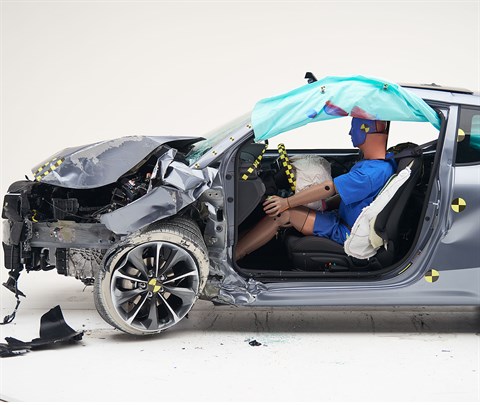
The dummy's position in relation to the door frame, steering wheel, and instrument panel after the crash test indicates that the driver's survival space was maintained very well.
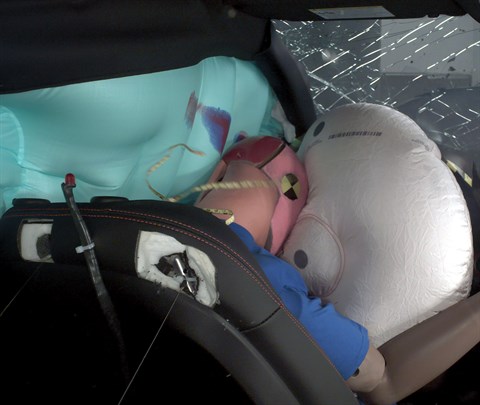
The frontal and side curtain airbags worked well together to keep the head from coming close to any stiff structure or outside objects that could cause injury.

The driver's space was maintained well, and risk of injuries to the dummy's legs and feet was low.
Small overlap front: passenger-side
Rating applies to 2019-22 models
Tested vehicle: 2019 Hyundai Veloster 2.0 Premium 3-door
The Hyundai Veloster was redesigned for the 2019 model year after a one-year absence from the market. The sporty hatchback features an unusual door configuration, with the passenger side having two conventionally hinged doors and the driver side only a single door.
Passenger-side small overlap frontal ratings are assigned by the Institute based on a test conducted by Hyundai.
| Evaluation criteria | Rating |
|---|---|
| Overall evaluation | |
| Structure and safety cage | |
| Passenger injury measures | |
| Head/neck | |
| Chest | |
| Hip/thigh | |
| Lower leg/foot | |
| Passenger restraints and dummy kinematics | |
| Driver injury measures | |
| Head/neck | |
| Chest | |
| Hip/thigh | |
| Lower leg/foot | |
| Driver restraints and dummy kinematics | |
Moderate overlap front: original test
Rating applies to 2019-22 models
Tested vehicle: 2019 Hyundai Veloster 2.0 Premium 3-door
The Hyundai Veloster was redesigned for the 2019 model year after a one-year absence from the market. The sporty hatchback features an unusual door configuration, with the passenger side having two conventionally hinged doors and the driver side only a single door.
Moderate overlap frontal ratings are assigned by the Institute based on a test conducted by Hyundai.
| Evaluation criteria | Rating |
|---|---|
| Overall evaluation | |
| Structure and safety cage | |
| Driver injury measures | |
| Head/neck | |
| Chest | |
| Leg/foot, left | |
| Leg/foot, right | |
| Driver restraints and dummy kinematics | |
Side: original test
Rating applies to 2019-22 models
Tested vehicle: 2019 Hyundai Veloster Turbo Ultimate 3-door
The Hyundai Veloster was redesigned for the 2019 model year after a one-year absence from the market. The sporty hatchback features an unusual door configuration, with the passenger side having two conventionally hinged doors and the driver side only a single door.
Two tests of the Veloster were conducted, the first by the Institute and the second by Hyundai. During the first test, the driver door opened. This opening didn't significantly affect vehicle crush or dummy movement but shouldn't happen because, in some crashes, it could allow partial or complete occupant ejection, especially if the occupant is unbelted.
The door opening led Hyundai to modify the cars to prevent this occurrence beginning with 2019 models built after January 2019, and Hyundai has implemented a recall to apply the same fix to cars built earlier. (Information about when a specific vehicle was manufactured is on the certification label typically affixed to the car on the driver door or adjacent B-pillar.)
In the second test conducted by Hyundai on a car with the modifications, the driver door did not open. Ratings of the Veloster are based on the results of both tests.
| Evaluation criteria | Rating |
|---|---|
| Overall evaluation | |
| Structure and safety cage | |
| Driver injury measures | |
| Head/neck | |
| Torso | |
| Pelvis/leg | |
| Driver head protection | |
| Rear passenger injury measures | |
| Head/neck | |
| Torso | |
| Pelvis/leg | |
| Rear passenger head protection | |
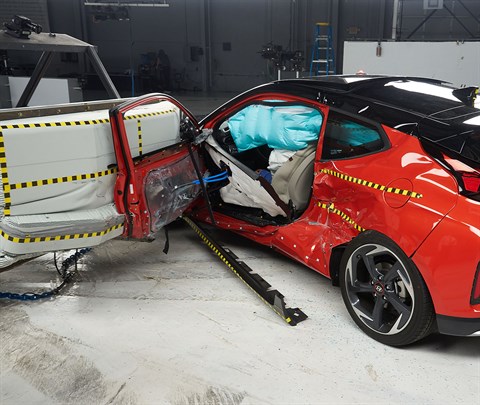
View of the vehicle and barrier just after the Institute's crash test. The driver door opened, but the dummy's movement during the crash wasn't significantly affected.
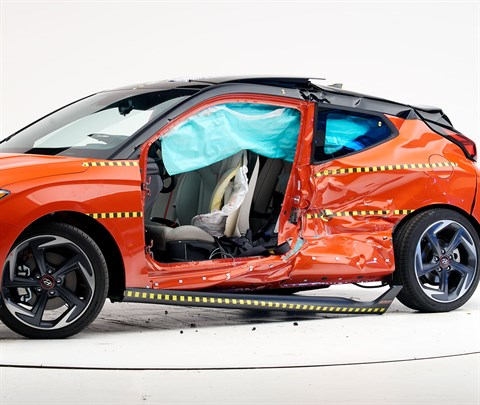
View of the vehicle after the crash with door removed, showing the side airbags and damage to the occupant compartment (Institute test car shown).
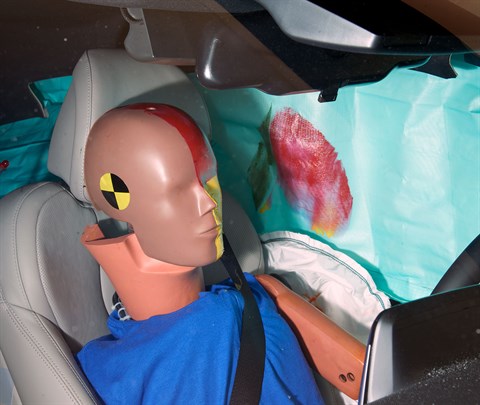
Smeared greasepaint shows where the driver dummy's head was protected from being hit by hard structures by the side curtain airbag in the Institute's test.

Smeared greasepaint shows where the rear passenger dummy’s head was protected by the side airbag.
Roof strength
Rating applies to 2019-22 models
Tested vehicle: 2019 Hyundai Veloster 2.0 3-door
| Overall evaluation | |
|---|---|
| Curb weight | 2,709 lbs |
| Peak force | 14,248 lbs |
| Strength-to-weight ratio | 5.26 |
Head restraints & seats
Seat type: Manual cloth seat
| Overall evaluation | |
|---|---|
| Dynamic rating | |
| Seat/head restraint geometry |
About the head restraint & seat test
Currently, IIHS tests apply only to front seats.
Headlights
Ratings are given for 3 different headlight variations available on this vehicle.
Trim level(s)
- Turbo R-Spec trim; built after August 2018
- Turbo trim; built after August 2018
- Turbo Ultimate trim; built after August 2018
| Evaluation criteria | Rating |
|---|---|
| Low-beam headlight type | LED projector |
| High-beam headlight type | Halogen reflector |
| Curve-adaptive? | No |
| High-beam assist? | Yes |
|
Overall rating | |
| Distance at which headlights provide at least 5 lux illumination: | |
Low beams
On the straightaway, visibility was good on both sides of the road. On curves, visibility was good in all 4 tests.
The low beams created some glare.
High beams
On the straightaway, visibility was good on the right side of the road and inadequate on the left side. On curves, visibility was good on the gradual left and gradual right curves and fair on the sharp left and sharp right curves.
High-beam assist compensates for some limitations of this vehicle's low beams on the sharp right curve.
Trim level(s)
- 2.0 trim
- 2.0 Premium trim
| Evaluation criteria | Rating |
|---|---|
| Low-beam headlight type | Halogen projector |
| High-beam headlight type | Halogen reflector |
| Curve-adaptive? | No |
| High-beam assist? | No |
|
Overall rating | |
| Distance at which headlights provide at least 5 lux illumination: | |
Low beams
On the straightaway, visibility was fair on the right side of the road and inadequate on the left side. On curves, visibility was inadequate in all 4 tests.
The low beams never exceeded glare limits.
High beams
On the straightaway, visibility was good on the right side of the road and inadequate on the left side. On curves, visibility was inadequate in all 4 tests.
Trim level(s)
- Turbo trim; built before September 2018
- Turbo R-Spec trim; built before September 2018
- Turbo Ultimate trim; built before September 2018
| Evaluation criteria | Rating |
|---|---|
| Low-beam headlight type | LED projector |
| High-beam headlight type | Halogen reflector |
| Curve-adaptive? | No |
| High-beam assist? | Yes |
|
Overall rating | |
| Distance at which headlights provide at least 5 lux illumination: | |
Low beams
On the straightaway, visibility was good on both sides of the road. On curves, visibility was good in all 4 tests.
The low beams created excessive glare.
High beams
On the straightaway, visibility was good on the right side of the road and inadequate on the left side. On curves, visibility was good on the gradual left and gradual right curves and fair on the sharp left and sharp right curves.
Front crash prevention: vehicle-to-vehicle
Ratings are given for 2 different trim variations available on this vehicle.
Front crash prevention: pedestrian (day)
Child seat anchors
Rating applies to 2019-22 models
| Evaluation criteria | Rating |
|---|---|
| Overall evaluation | |
| Vehicle trim | Turbo Ultimate |
| Seat type | leather |
This vehicle has 2 rear seating positions with complete child seat attachment (LATCH) hardware.
| Evaluation criteria | Rating |
|---|---|
| Overall evaluation | |
| Vehicle trim | Turbo Ultimate |
| Seat type | leather |
| Rating icon | Rating |
|---|---|
| G | Good |
| A | Acceptable |
| M | Marginal |
| P | Poor |
| Seating positions that rely on borrowed lower anchors or have only a tether anchor available are not rated. | |
thether anchor symbol | Tether anchor |
lower anchor symbol | Lower anchors |
| Lower anchor(s) can be borrowed from adjacent positions(s) | |
| No hardware available |
Details by seating position
| Position | Rating |
|---|---|
| 1 | |
| Tether anchor | |
| hard-to-find location | |
| no other hardware could be confused for anchor | |
| Lower anchors | |
| too deep in seat | |
| not too much force needed to attach | |
| easy to maneuver around anchors | |
| 3 | |
| Tether anchor | |
| hard-to-find location | |
| no other hardware could be confused for anchor | |
| Lower anchors | |
| too deep in seat | |
| not too much force needed to attach | |
| easy to maneuver around anchors |
